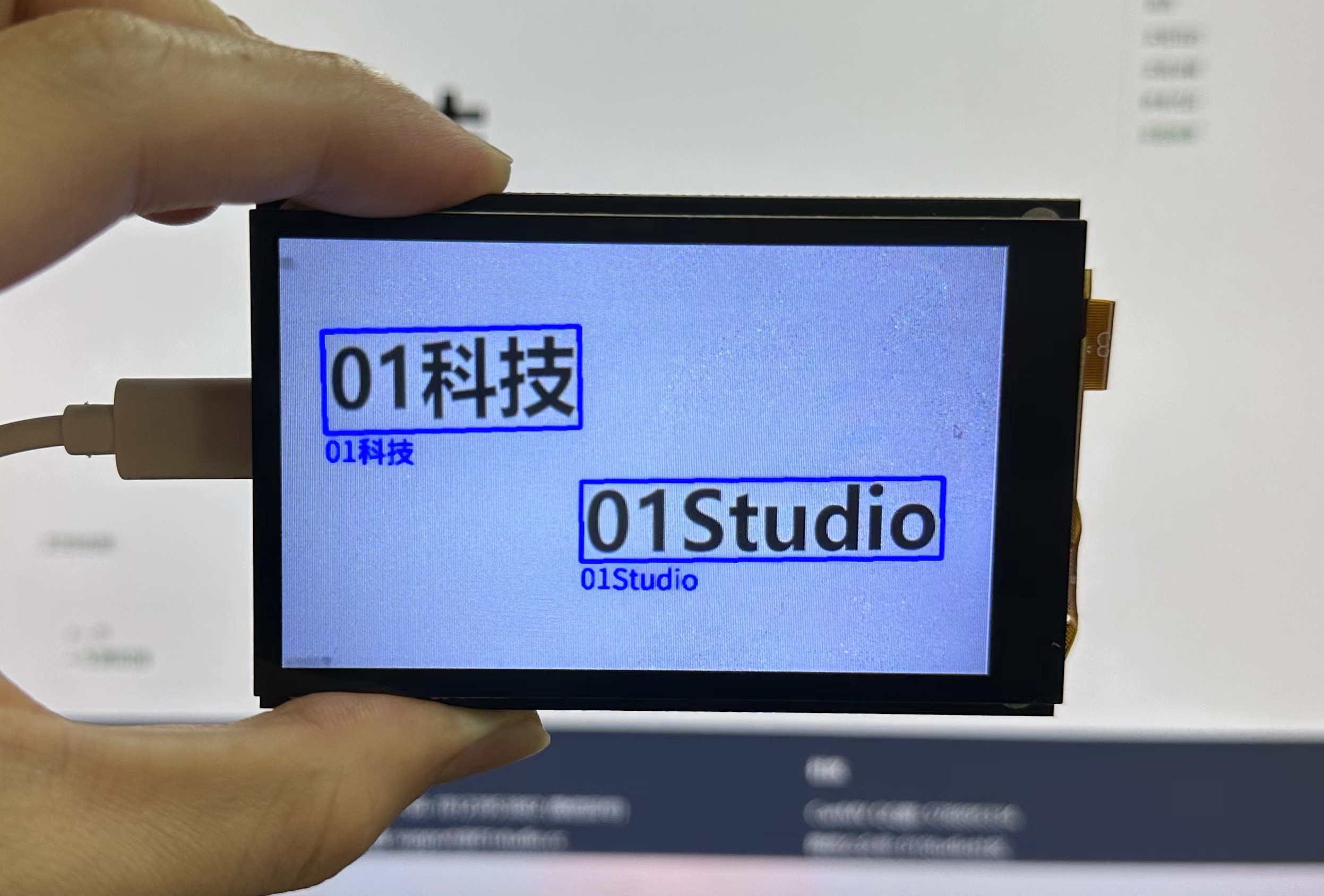字符识别(OCR)
前言
OCR (Optical Character Recognition,光学字符识别)是指电子设备(例如扫描仪或数码相机)检查纸上打印的字符,通过检测暗、亮的模式确定其形状,然后用字符识别方法将形状翻译成计算机文字的过程。
实验目的
编程实现图片中的字符识别(支持中文和英文)。
实验讲解
本实验通过CanMV K230 AI视觉框架开发,详细说明参考 AI视觉开发框架 章节内容,这里不再重复。例程用到的模型已经存放在CanMV K230的文件系统,无需额外拷贝。
具体编程思路如下:
参考代码
'''
实验名称:字符识别(OCR)
实验平台:01Studio CanMV K230
教程:wiki.01studio.cc
说明:可以通过display="xxx"参数选择"hdmi"、"lcd3_5"(3.5寸mipi屏)或"lcd2_4"(2.4寸mipi屏)显示方式
'''
from libs.PipeLine import PipeLine, ScopedTiming
from libs.AIBase import AIBase
from libs.AI2D import Ai2d
import os
import ujson
from media.media import *
from media.sensor import *
from time import *
import nncase_runtime as nn
import ulab.numpy as np
import time
import image
import aicube
import random
import gc
import sys
# 自定义OCR检测类
class OCRDetectionApp(AIBase):
def __init__(self,kmodel_path,model_input_size,mask_threshold=0.5,box_threshold=0.2,rgb888p_size=[224,224],display_size=[1920,1080],debug_mode=0):
super().__init__(kmodel_path,model_input_size,rgb888p_size,debug_mode)
self.kmodel_path=kmodel_path
# 模型输入分辨率
self.model_input_size=model_input_size
# 分类阈值
self.mask_threshold=mask_threshold
self.box_threshold=box_threshold
# sensor给到AI的图像分辨率
self.rgb888p_size=[ALIGN_UP(rgb888p_size[0],16),rgb888p_size[1]]
# 显示分辨率
self.display_size=[ALIGN_UP(display_size[0],16),display_size[1]]
self.debug_mode=debug_mode
# Ai2d实例,用于实现模型预处理
self.ai2d=Ai2d(debug_mode)
# 设置Ai2d的输入输出格式和类型
self.ai2d.set_ai2d_dtype(nn.ai2d_format.NCHW_FMT,nn.ai2d_format.NCHW_FMT,np.uint8, np.uint8)
# 配置预处理操作,这里使用了pad和resize,Ai2d支持crop/shift/pad/resize/affine,具体代码请打开/sdcard/libs/AI2D.py查看
def config_preprocess(self,input_image_size=None):
with ScopedTiming("set preprocess config",self.debug_mode > 0):
# 初始化ai2d预处理配置,默认为sensor给到AI的尺寸,您可以通过设置input_image_size自行修改输入尺寸
ai2d_input_size=input_image_size if input_image_size else self.rgb888p_size
top,bottom,left,right=self.get_padding_param()
self.ai2d.pad([0,0,0,0,top,bottom,left,right], 0, [0,0,0])
self.ai2d.resize(nn.interp_method.tf_bilinear, nn.interp_mode.half_pixel)
self.ai2d.build([1,3,ai2d_input_size[1],ai2d_input_size[0]],[1,3,self.model_input_size[1],self.model_input_size[0]])
# 自定义当前任务的后处理
def postprocess(self,results):
with ScopedTiming("postprocess",self.debug_mode > 0):
# chw2hwc
hwc_array=self.chw2hwc(self.cur_img)
# 这里使用了aicube封装的接口ocr_post_process做后处理,返回的det_boxes结构为[[crop_array_nhwc,[p1_x,p1_y,p2_x,p2_y,p3_x,p3_y,p4_x,p4_y]],...]
det_boxes = aicube.ocr_post_process(results[0][:,:,:,0].reshape(-1), hwc_array.reshape(-1),self.model_input_size,self.rgb888p_size, self.mask_threshold, self.box_threshold)
return det_boxes
# 计算padding参数
def get_padding_param(self):
# 右padding或下padding
dst_w = self.model_input_size[0]
dst_h = self.model_input_size[1]
input_width = self.rgb888p_size[0]
input_high = self.rgb888p_size[1]
ratio_w = dst_w / input_width
ratio_h = dst_h / input_high
if ratio_w < ratio_h:
ratio = ratio_w
else:
ratio = ratio_h
new_w = (int)(ratio * input_width)
new_h = (int)(ratio * input_high)
dw = (dst_w - new_w) / 2
dh = (dst_h - new_h) / 2
top = (int)(round(0))
bottom = (int)(round(dh * 2 + 0.1))
left = (int)(round(0))
right = (int)(round(dw * 2 - 0.1))
return top, bottom, left, right
# chw2hwc
def chw2hwc(self,features):
ori_shape = (features.shape[0], features.shape[1], features.shape[2])
c_hw_ = features.reshape((ori_shape[0], ori_shape[1] * ori_shape[2]))
hw_c_ = c_hw_.transpose()
new_array = hw_c_.copy()
hwc_array = new_array.reshape((ori_shape[1], ori_shape[2], ori_shape[0]))
del c_hw_
del hw_c_
del new_array
return hwc_array
# 自定义OCR识别任务类
class OCRRecognitionApp(AIBase):
def __init__(self,kmodel_path,model_input_size,dict_path,rgb888p_size=[1920,1080],display_size=[1920,1080],debug_mode=0):
super().__init__(kmodel_path,model_input_size,rgb888p_size,debug_mode)
# kmodel路径
self.kmodel_path=kmodel_path
# 识别模型输入分辨率
self.model_input_size=model_input_size
self.dict_path=dict_path
# sensor给到AI的图像分辨率,宽16字节对齐
self.rgb888p_size=[ALIGN_UP(rgb888p_size[0],16),rgb888p_size[1]]
# 视频输出VO分辨率,宽16字节对齐
self.display_size=[ALIGN_UP(display_size[0],16),display_size[1]]
# debug模式
self.debug_mode=debug_mode
self.dict_word=None
# 读取OCR的字典
self.read_dict()
self.ai2d=Ai2d(debug_mode)
self.ai2d.set_ai2d_dtype(nn.ai2d_format.RGB_packed,nn.ai2d_format.NCHW_FMT,np.uint8, np.uint8)
# 配置预处理操作,这里使用了pad和resize,Ai2d支持crop/shift/pad/resize/affine,具体代码请打开/sdcard/libs/AI2D.py查看
def config_preprocess(self,input_image_size=None,input_np=None):
with ScopedTiming("set preprocess config",self.debug_mode > 0):
ai2d_input_size=input_image_size if input_image_size else self.rgb888p_size
top,bottom,left,right=self.get_padding_param(ai2d_input_size,self.model_input_size)
self.ai2d.pad([0,0,0,0,top,bottom,left,right], 0, [0,0,0])
self.ai2d.resize(nn.interp_method.tf_bilinear, nn.interp_mode.half_pixel)
# 如果传入input_np,输入shape为input_np的shape,如果不传入,输入shape为[1,3,ai2d_input_size[1],ai2d_input_size[0]]
self.ai2d.build([input_np.shape[0],input_np.shape[1],input_np.shape[2],input_np.shape[3]],[1,3,self.model_input_size[1],self.model_input_size[0]])
# 自定义后处理,results是模型输出的array列表
def postprocess(self,results):
with ScopedTiming("postprocess",self.debug_mode > 0):
preds = np.argmax(results[0], axis=2).reshape((-1))
output_txt = ""
for i in range(len(preds)):
# 当前识别字符不是字典的最后一个字符并且和前一个字符不重复(去重),加入识别结果字符串
if preds[i] != (len(self.dict_word) - 1) and (not (i > 0 and preds[i - 1] == preds[i])):
output_txt = output_txt + self.dict_word[preds[i]]
return output_txt
# 计算padding参数
def get_padding_param(self,src_size,dst_size):
# 右padding或下padding
dst_w = dst_size[0]
dst_h = dst_size[1]
input_width = src_size[0]
input_high = src_size[1]
ratio_w = dst_w / input_width
ratio_h = dst_h / input_high
if ratio_w < ratio_h:
ratio = ratio_w
else:
ratio = ratio_h
new_w = (int)(ratio * input_width)
new_h = (int)(ratio * input_high)
dw = (dst_w - new_w) / 2
dh = (dst_h - new_h) / 2
top = (int)(round(0))
bottom = (int)(round(dh * 2 + 0.1))
left = (int)(round(0))
right = (int)(round(dw * 2 - 0.1))
return top, bottom, left, right
def read_dict(self):
if self.dict_path!="":
with open(dict_path, 'r') as file:
line_one = file.read(100000)
line_list = line_one.split("\r\n")
self.dict_word = {num: char.replace("\r", "").replace("\n", "") for num, char in enumerate(line_list)}
class OCRDetRec:
def __init__(self,ocr_det_kmodel,ocr_rec_kmodel,det_input_size,rec_input_size,dict_path,mask_threshold=0.25,box_threshold=0.3,rgb888p_size=[1920,1080],display_size=[1920,1080],debug_mode=0):
# OCR检测模型路径
self.ocr_det_kmodel=ocr_det_kmodel
# OCR识别模型路径
self.ocr_rec_kmodel=ocr_rec_kmodel
# OCR检测模型输入分辨率
self.det_input_size=det_input_size
# OCR识别模型输入分辨率
self.rec_input_size=rec_input_size
# 字典路径
self.dict_path=dict_path
# 置信度阈值
self.mask_threshold=mask_threshold
# nms阈值
self.box_threshold=box_threshold
# sensor给到AI的图像分辨率,宽16字节对齐
self.rgb888p_size=[ALIGN_UP(rgb888p_size[0],16),rgb888p_size[1]]
# 视频输出VO分辨率,宽16字节对齐
self.display_size=[ALIGN_UP(display_size[0],16),display_size[1]]
# debug_mode模式
self.debug_mode=debug_mode
self.ocr_det=OCRDetectionApp(self.ocr_det_kmodel,model_input_size=self.det_input_size,mask_threshold=self.mask_threshold,box_threshold=self.box_threshold,rgb888p_size=self.rgb888p_size,display_size=self.display_size,debug_mode=0)
self.ocr_rec=OCRRecognitionApp(self.ocr_rec_kmodel,model_input_size=self.rec_input_size,dict_path=self.dict_path,rgb888p_size=self.rgb888p_size,display_size=self.display_size)
self.ocr_det.config_preprocess()
# run函数
def run(self,input_np):
# 先进行OCR检测
det_res=self.ocr_det.run(input_np)
boxes=[]
ocr_res=[]
for det in det_res:
# 对得到的每个检测框执行OCR识别
self.ocr_rec.config_preprocess(input_image_size=[det[0].shape[2],det[0].shape[1]],input_np=det[0])
ocr_str=self.ocr_rec.run(det[0])
ocr_res.append(ocr_str)
boxes.append(det[1])
gc.collect()
return boxes,ocr_res
# 绘制OCR检测识别效果
def draw_result(self,pl,det_res,rec_res):
pl.osd_img.clear()
if det_res:
# 循环绘制所有检测到的框
for j in range(len(det_res)):
# 将原图的坐标点转换成显示的坐标点,循环绘制四条直线,得到一个矩形框
for i in range(4):
x1 = det_res[j][(i * 2)] / self.rgb888p_size[0] * self.display_size[0]
y1 = det_res[j][(i * 2 + 1)] / self.rgb888p_size[1] * self.display_size[1]
x2 = det_res[j][((i + 1) * 2) % 8] / self.rgb888p_size[0] * self.display_size[0]
y2 = det_res[j][((i + 1) * 2 + 1) % 8] / self.rgb888p_size[1] * self.display_size[1]
pl.osd_img.draw_line((int(x1), int(y1), int(x2), int(y2)), color=(255, 0, 0, 255),thickness=5)
pl.osd_img.draw_string_advanced(int(x1),int(y1),32,rec_res[j],color=(0,0,255))
if __name__=="__main__":
# 显示模式,可以选择"hdmi"、"lcd3_5"(3.5寸mipi屏)和"lcd2_4"(2.4寸mipi屏)
display="lcd3_5"
if display=="hdmi":
display_mode='hdmi'
display_size=[1920,1080]
elif display=="lcd3_5":
display_mode= 'st7701'
display_size=[800,480]
elif display=="lcd2_4":
display_mode= 'st7701'
display_size=[640,480]
rgb888p_size=[640,360] #特殊尺寸定义
# OCR检测模型路径
ocr_det_kmodel_path="/sdcard/examples/kmodel/ocr_det_int16.kmodel"
# OCR识别模型路径
ocr_rec_kmodel_path="/sdcard/examples/kmodel/ocr_rec_int16.kmodel"
# 其他参数
dict_path="/sdcard/examples/utils/dict.txt"
ocr_det_input_size=[640,640]
ocr_rec_input_size=[512,32]
mask_threshold=0.25
box_threshold=0.3
# 初始化PipeLine,只关注传给AI的图像分辨率,显示的分辨率
pl=PipeLine(rgb888p_size=rgb888p_size,display_size=display_size,display_mode=display_mode)
if display =="lcd2_4":
pl.create(Sensor(width=1280, height=960)) # 创建PipeLine实例,画面4:3
else:
pl.create(Sensor(width=1920, height=1080)) # 创建PipeLine实例
ocr=OCRDetRec(ocr_det_kmodel_path,ocr_rec_kmodel_path,det_input_size=ocr_det_input_size,rec_input_size=ocr_rec_input_size,dict_path=dict_path,mask_threshold=mask_threshold,box_threshold=box_threshold,rgb888p_size=rgb888p_size,display_size=display_size)
clock = time.clock()
while True:
clock.tick()
img=pl.get_frame() # 获取当前帧
det_res,rec_res=ocr.run(img) # 推理当前帧
ocr.draw_result(pl,det_res,rec_res) # 绘制当前帧推理结果
print(det_res,rec_res) # 打印结果
pl.show_image() # 展示当前帧推理结果
gc.collect()
print(clock.fps()) #打印帧率
这里对关键代码进行讲解:
- 主函数代码:
可以看到使用默认配置后只使用了4行代码便实现了获取当前帧图像、AI推理、绘制结果、显示结果 的识别流程。
代码中 det_res为字符位置检测结果, rec_res为字符识别内容结果。
...
while True:
clock.tick()
img=pl.get_frame() # 获取当前帧
det_res,rec_res=ocr.run(img) # 推理当前帧
ocr.draw_result(pl,det_res,rec_res) # 绘制当前帧推理结果
print(det_res,rec_res) # 打印结果
pl.show_image() # 展示当前帧推理结果
gc.collect()
print(clock.fps()) #打印帧率
...
实验结果
在CanMV IDE中运行上述代码,将摄像头正对下方字符。
原图:

识别结果:
